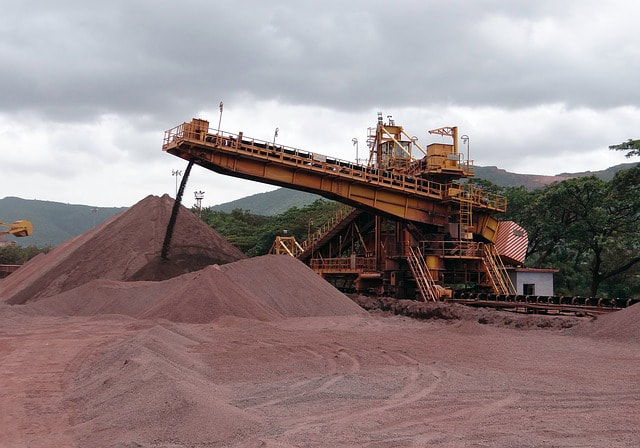

Author: Sid Ruttala
We’ve previously – late last year – made the bull case around the spot prices for iron ore (when the ore was trading at approx. 120 USD/T). Our reasoning here was summarised in a twofold explanation; 1) demand due to the likelihood of steel output staying consistent due to flooding in China; and 2) the increased fiscal expenditure globally, largely on infrastructure, which should see a disentanglement of the spot prices from Chinese demand.
Recent price action, however, suggested otherwise with spot prices tumbling from a peak of 228 USD/T in May to now trading at 117 USD/T (at the time of writing). So, what’s happened and why the decline?
The elephant in the room remains China. With China accounting for 70-75% of iron ore imports globally, any changes in demand have outsized impacts upon the global market. Beijing recently imposed caps on steel output as a result of and in the lead up to the 2022 Winter Olympics in the hopes of cutting emissions and controlling pollution. With domestic output having been allowed to expand beyond these caps through 1H21, we are likely to see continued declines until at least February of next year when the Winter Olympics are to be held. Combine this with some production coming back online in the form of Vale (Brazil), we have what may be considered a perfect storm.
Let’s now return to the second part of our argument; the disentanglement of spot prices from Chinese demand. Here we are seeing signs of reprieve. Take, for example, German import prices released by the Federal Statistics office, which saw the largest increases in import prices in close to forty years. Although this may be a result of supply bottlenecks, we are seeing increased demand for raw materials, with iron ore cost and end steel rising 95.8% in August, a period in which China’s imports of the product also hit peak. This indicates to us two things; first, Beijing may have coordinated a scenario where first half production was intentionally pushed above caps to taper off in the second half in the lead up to the Winter Olympics and, second, there is still surging global demand for the product on a longer term basis. This second aspect seems to be at play here. Major steel-producing provinces and regions are seeing inventory declines even during the offseason, with higher transaction volumes than would typically be the case in off-season markets this time of the year.
All this is to say that we are likely to see demand pick up with a vengeance coming out of the Winter Olympics and a rather messy situation in the lead up. This may be somewhat mitigated by shorter-term supply issues in the form of Vale, the most recent of which being 39 miners getting trapped in an underground mine at Totten. Nevertheless, we are still likely to see negative price action in 2H21 (or at the very least a consolidation pattern sideways) with 90 USD/T a great possibility.
Looking to the longer term, however, our thesis broadly remains intact. That is, the continued fiscal impetus globally should see a rather massive tailwind for raw materials and steel. The oft touted Green New Deal Stateside is, in our view, likely to gain momentum in some form despite the recent gridlock in Congress. The more liberal wing of the democratic party may get its way with the stimulus bill despite facing an uphill challenge in the Senate. Why do we say so?
The political imperative remains strong. Think for a moment about the voting patterns of the so-called Rust Belt and where US steel production is likely to take place should some semblance of the expansive infrastructure package be rolled out. These remain key and decisive swing states, Pennsylvania being one and Indiana, a key Republican stronghold and the largest producer of US steel, being another. All things equal, we are likely to see some incentive and political consensus especially when it comes to this aspect. What does this have to do with iron ore? Simple, we are likely to see further demand increases from the US.
Looking more globally, other key players continue to be the EU, where the marked shift to renewables is gaining traction for better or worse (most recently it has been in the news because of supply bottlenecks in traditional fossil fuels and an inability to cope with increased demand during winter). Nevertheless, we continue to see increasingly aggressive targets set by the Commission which formulated a directive to have 32% of energy consumption come from renewables by 2030. This came with a clause for upward revision in 2023 and carbon neutrality by 2050 (i.e. Renewable Energy Directive 2018/2001). Looking to emerging markets such as India where, notwithstanding recent cyclones that have buffeted steel producing states like Andhra Pradesh, we are seeing what could be termed as an infrastructure boom enabled by the government. Longer term, we see continued impetus on infrastructure spending, specifically transport infrastructure. We have seen the most recent union budget allocating close to $32bn US to the sector and new initiatives to wean the country off its reliance on diesel. Again, a focus on renewables also bodes well for the demand for iron ore. This remains a longer term play however, with ore imports still facing stiff competition and the steel industry being very much in its infancy.
So, buy now or wait it out?
For the purposes of this article, let’s limit ourselves to the big three, BHP, RIO and FMG. All three have seen incredible declines from peak to trough. -32% for BHP, -43% for FMG, -28% for RIO. We make the case that, given the above rationale, the market may have overdone it. But, even assuming a 90 USD/T base case, we would still extrapolate a return to investors of 25% for BHP at this price (inclusive of dividend yield and assuming continued payout ratios of 90%). This is within the context of the spin-off in the petroleum business, continued upward pressure in the other aspect of steel production, coking coal, and BHP’s recent move into potash which we estimate should give an internal rate of return of 15% over the next 5 years (this is above management guidance (12-14%) given where we see agricultural markets going, but that is an article in and of itself). So, BHP? Perhaps a good buy.
Let’s get to Rio which continued to sell off, perhaps not as aggressively as the other two but consistent nevertheless. We also found this to be a little overdone and the market seems to have misplaced or overlooked the fact that this particular business has some of the largest uranium mining operations in the world. Given our thesis around that particular commodity (which we wrote about last year), we think RIO presents as a solid buy at the current price of $96.89 AUD. This implies a dividend yield of 10.9%, however, let us strip out the recent price action in iron ore and in fact go with the lower bear case of 90 USD/T, assuming current payout ratios hold we would still expect a yield of 8%.
So, basically, sell offs have been painful if you where an investor but all three present opportunities going forward in our view. BHP and RIO offer good value at current prices while FMG offers exceptional value if (and only if) you agree with our contention around the future of iron ore prices.


